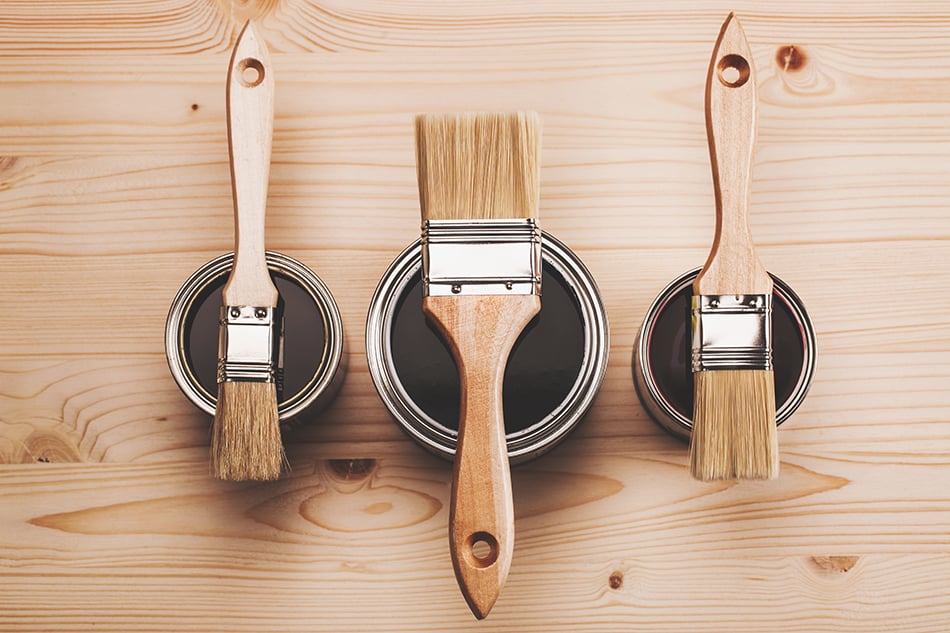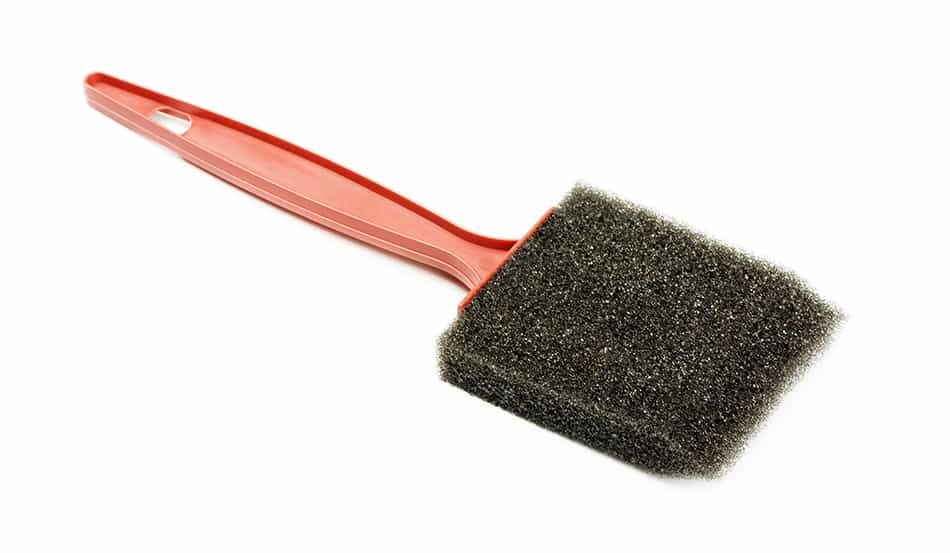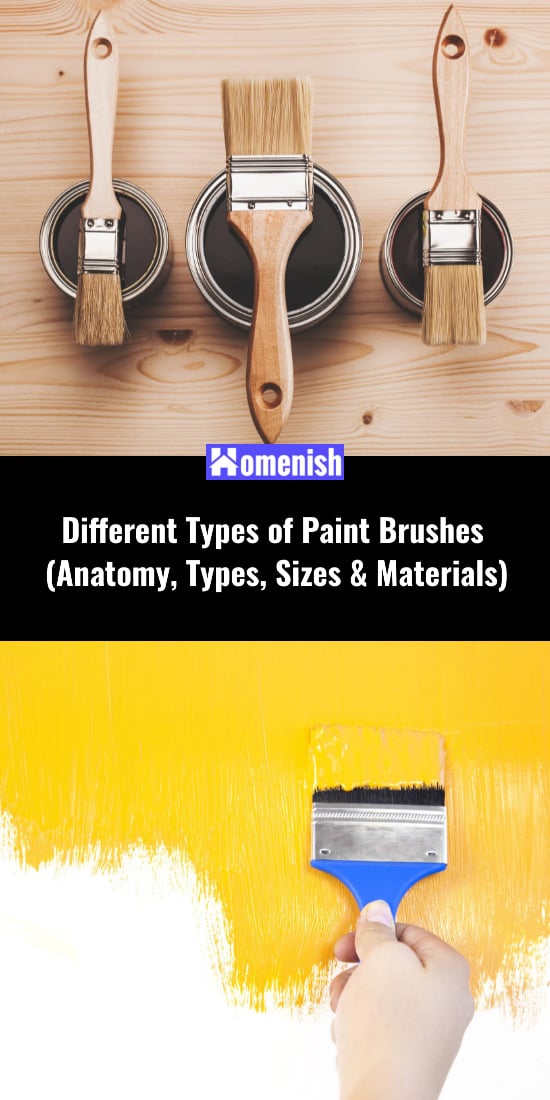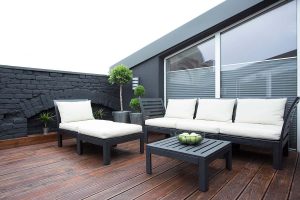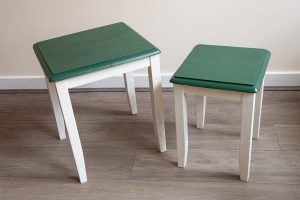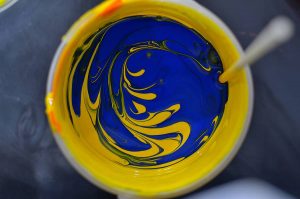What type of paint brush do you need for your project? That depends largely on whether you’re painting a wall, a piece of furniture, or an art project. And of course, if you’re engaged in artwork, the type of brush you want will depend on your medium and the look you’re trying to achieve.
If you’re using more of a utility brush, you want to consider things like size and shape to best accomplish your task efficiently without making a mess. In general, utility brushes are larger than craft brushes and are not as delicate, though you can certainly see exceptions in things like finishing and round sash brushes.
Let’s take a look at the wide of variety of brushes to help you decide which one to use.
Parts of a Paint Brush
Take a look at the anatomy of a paintbrush. All the distinctions between brushes can impact your work.
Handle
The handle of a brush is most frequently made from wood that’s painted or varnished, though it can likewise be made from plastic or bamboo. What’s more crucial than length is that the brush feels well balanced in your hand.
You also want to consider the thickness of the handle. Is it comfortable to hold? If you’re doing detail work, you may need to hold it for extended periods, and you don’t want your hand cramping up.
Also, does the thickness allow you to hold it in such a way that gives you the best control? For art projects, you often want to hold your brush between your fingers, like a pencil. For utility work, it’s often to okay wrap your palm around the brush.
Bristles/Hairs
What bristles or hairs compose the brush is likewise variable, depending upon what the brush is meant for. It’s essential is that they’re strongly held in place and aren’t going to fall out little by little as you paint.
Interestingly, the first paint brushes were little more than animal tails and clumped hog bristles, and you can still find brushes made with these types of organic materials. Brushes will also have differently shaped bristles – flat, round, angled, pointed, etc. – to give you the intended result. Some are stiffer or softer, so make sure you experiment with different bristle types and shapes to see how they perform.
Paintbrushes of the same type differ in bristle thickness. A thick brush will hold significantly more paint if you’re painting with watercolor or extremely fluid paint. This allows you to paint for a longer time without stopping. If you desire a brush for dry-brush strategies, you might well desire a brush that holds less paint.
The toe of a brush is the very end of the bristles, while the heel is where the bristles go into the ferrule at the end of the handle (not that you can generally see this without taking a brush apart). The tummy is the fattest part of a brush.
Ferrule
The ferrule connects the bristles to the handle. It’s normally made from metal, though not solely. Mop brushes, for example, can have a ferrule made of plastic and wire. The important thing here is that the ferrule keeps the bristles securely in place and is easy to clean.
Cheaper brushes have loose ferrules that allow the bristles to come out in your paint. Others are irregularly shaped, allowing paint to get into hard-to-clean areas.
Type of Paintbrushes
How you want to use a brush will determine which type is right for any single project. Keep in mind, though, that all painting is art, and some fine art requires the look of a utility brush, so the lines between the categories are very fluid.
It’s best to educate yourself on the following bristle shapes and materials so that you’ll be familiar with what type of brush can give you your desired look.
Paint Brush Shapes
Wall
This is a large brush with a square and flat end. They’re meant to cover large areas, such as the open area of a wall. They’re not for detail work. One advantage of a wall brush is that they are offered with a range of various bristle types.
Flagged Bristle
Many square-cut brushes have this type of bristle. It gives your bristles more surface area so that you can pick up more paint with each dip into the can or tray. Again, it’s about getting the most paint on a surface as quickly as possible. Detail and caution isn’t much of a concern.
Angled Sash
Bristles on this type of brush have actually been cut into a slant, making it considerably simpler to ensure you have great, clean lines as you paint. You would use this brush to butt up to corners where one side gets painted and the other doesn’t, or to work around trim or doorframes. They might also be good for larger woodworking projects or the like – anywhere you want to cover a large area while maintaining control of where the paint goes.
Trim
A trim brush has an extremely short handle to provide more control. Use it like an angled sash if this is more comfortable for you.
Finishing
The bristles of these brushes are considerably softer than other types and are typically made from ox hair. They create a smooth texture – no lines or brush marks. They also give you a great deal of control over your paint application.
Round Sash
This type of brush has an extremely blunt end. It has soft edges and is tapered. They are typically much smaller sized than other kinds of paintbrushes.
Foam
Foam brushes are good to use on specific surface materials that don’t take paint well. They can often apply paint more thickly and evenly than other brushes, making them useful for laying down a solid first coat.
Foam brushes are particularly developed to have the capacity for holding a lot of stain, urethane, and paint.
Stencil
For drawing any stencil designs on your walls, make sure you have this kind of brush. It will provide the cleanest, most even finish to let your design pop.
Paintbrush Bristle Materials
Like utility vs. craft brushes, there are two main categories of bristle materials: natural and synthetic.
Natural
Bristles made of natural hairs or bristles are best for latex or acrylic paints. They create smooth finishes with these types of paints. Using natural bristles with water-based paint, however, causes them to become sticky and lose their shape. When that happens, your paint doesn’t go on evenly, it leaves brush marks, and you make a lot of mistakes “coloring outside the lines.”
Here are the types of natural bristles you can buy.
Ox Hair
Made from the hairs of real ox ears, these bristles are exceptionally soft, and each bristle merges into a fine point instead of the brush featuring flagged ends, as hog hair filaments do.
You will also see brushes that have both hog hair and ox bristles integrated, as this guarantees the brush will be more long-lasting and will be able to hold more paint than a brush made just from ox hair.
Also, the ox hair in these combined brushes will ensure the paint stays smooth, while the hog bristles keep the brush stiff. These types of brushes are more costly than other kinds of natural brushes.
Black China Bristle
Made from Black China boar bristles, these work best for use with all alcohol, solvent, and oil-based stains and paints. They’re very firm, won’t lose their shape, or break, but they won’t create a smooth finish either. Use them for first coats or on surfaces that don’t need a smooth finish.
White China Bristle
These bristles are generally much softer to the touch than those utilized in Black China brushes. They’re terrific for using with oil-based and solvent paints and are an ideal option if you wish to ensure you have a smooth surface when you are finished.
They are perfect for both outside and interior painting tasks, and while the bristles have flagged ends similar to those on Black China paint brushes, they are far gentler, which will enable you to create a smooth and perfectly clean surface area for your paint job.
Synthetic
Turning now to synthetic materials, these are best if you’re using water-based paints. That’s because they don’t absorb water. They also keep their shape better than natural bristles. There are however, different kinds of artificial bristles, and selecting the wrong type can cause significant issues for a painting project.
Let’s take a look at the variety available to you in this category. One benefit to be aware of before we move on, though, is that these synthetic brushes are generally lower cost than natural brushes. Rather than being sourced from animals, they can be engineered and produced rapidly. How the artist in you feels about this mass production is up to you.
Nylon
Nylon brushes are typically exceptionally long-lasting and easy to clean, making them the most common type of synthetic paintbrush material. They’re softer than other types of synthetics, which makes them good for creating smooth surfaces. Don’t use them on rough surfaces, though, as the lack of firmness won’t spread paint well on this type of material.
Also, watch out for using these in hot weather or where there’s a lot of humidity, as the bristles will lose their shape. It’s best to use this type of brush inside where you can control the climate.
Engineered Nylon
This is the new and improved version of nylon bristles. You can use them in any weather condition without worrying about them bending or spreading. They’re actually designed to be stiffer. Of course, that means you don’t want to use them when you’re trying to create a smooth finish. These are more for semi-smooth surfaces. Also, because they’re an upgrade, they’re more expensive than common nylon.
Polyester
Bristles made of polyester won’t wilt in high humidity, but nor will they create smooth finishes. In fact, polyester is the worst for leaving brush marks in your paint. You can, however, use them for any kind of paint, and they work especially for outdoor projects.
The final point to mention is that they are difficult to clean, meaning they’re best used as one and done brushes. Throw them away after each use and start your next project with a clean brush. If your budget doesn’t allow for this, it may be best to choose nylon or a natural bristle type.
Polyester/Nylon Blend
Like the ox hair-boar bristle combo in the natural paintbrush category, combining nylon and polyester gives you best of the synthetic types.
By choosing this type, you’ll get a paintbrush that has the stiffness of polyester and can maintain its shape for long hours of continual use, yet is soft and still long lasting as nylon brushes generally are. This type of brush works well for all kinds of paint. Moreover, weather and humidity are non-issues.
You can also use them on any surface area and be confident of a smooth finish. They can be a bit harder to clean, due to the addition of the polyester in them; however, as they are such an excellent brush type for so many circumstances, they are an excellent option to have around, even if you do have to replace them at a higher cost.
Sizes of Paintbrushes
So, that covers shapes and bristle types, which leaves only size to consider. In general, utility brushes will be larger than art brushes, but you can certainly find exceptions. And remember, a certain size brush may be any shape and contain any of the natural or synthetic bristles mentioned above.
Let’s take a look at the common sizes of paintbrushes and what you would want to use them for.
1″
As you can imagine, these won’t cover a large area very quickly, but they will give you a lot of control when you’re painting a relatively small area. Search for a long-handled brush that keeps the overall profile of the brush extremely narrow for slipping into smaller sized spots. Also, select a handle you can be comfortable holding throughout your painting task.
2″
This and the 3-inch brush is what you’ll use most often for utility projects. They give you decent coverage but aren’t so large as to lead to mistakes. When you look for a 2″ brush, be certain that you search for one that has softer bristles.
While firmer bristles will make sure that a brush can last for a long period of time, the boost in bristle stiffness can make little flaws in the paint surface, while brushes with softer bristles will make sure that you do not have this issue.
3″
Now you’re covering a big area in a short time. Just ensure that when you select a 3-inch size brush, you find one with consistent bristles strongly connected to the ferrule, so that you do not need to stress over them falling out into your paint. You’re going to be carrying a lot of paint with this brush, and that weight can loosen the bristles on cheaper brushes.
4″
At this point, you might consider using a roller instead of a brush, but a brush still gives you greater control. And besides, you might want the brushed look, depending on what you’re painting.
When you do buy a brush this large, try to find one with a really tough handle but that will be comfortable for you to hold, as you will be moving a great deal of weight in between the paint you are using and the brush itself, and you do not need your hand to start aching or getting worn out.
Why Not Buy a Set of Paint Brushes?
As you can see, there’s a lot to painting, and we’ve only covered the brushes! That still leaves the paint itself and the different techniques you can employ. But at least this will get you started by knowing what to look for.
You can spot the qualities of the parts of a brush and know what each size, shape, and bristle type is used for.
But you probably won’t have every brush that you require for every paint job right away if you are just getting started building your arsenal. And it can be extremely aggravating having to run to the shop and purchase specific brushes when you need them. That’s why it’s such a great idea to think about purchasing your paintbrushes as a set.
While you are probably going to want to trade out your brushes for better ones down the line (and specifically as you learn what types of brushes work best for you), this is a terrific method to ensure that you have a range of designs and sizes to pick from so that you can start your painting jobs as soon as possible.
